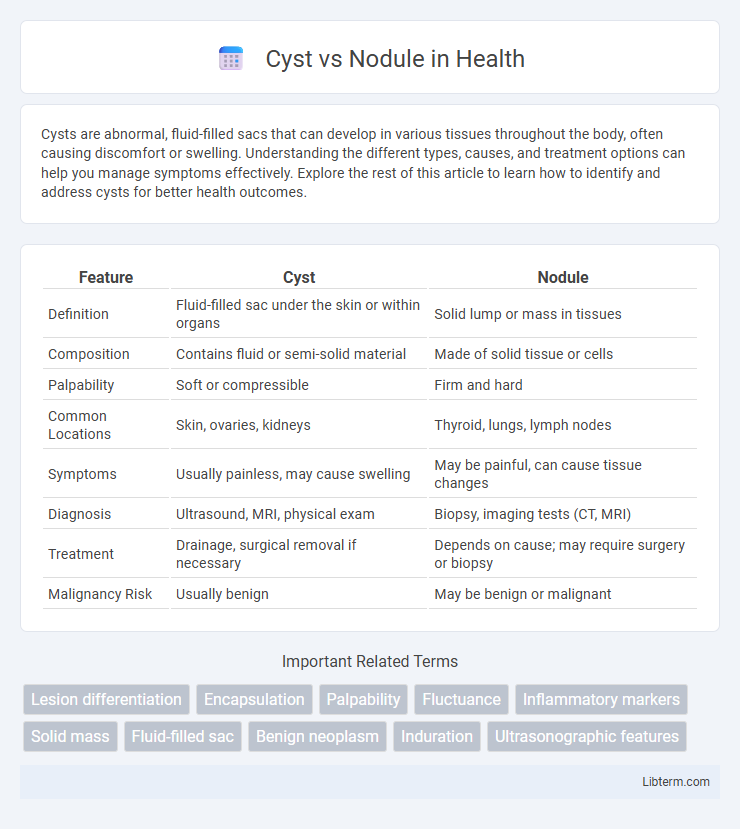Cysts are abnormal, fluid-filled sacs that can develop in various tissues throughout the body, often causing discomfort or swelling. Understanding the different types, causes, and treatment options can help you manage symptoms effectively. Explore the rest of this article to learn how to identify and address cysts for better health outcomes.
Table of Comparison
| Feature | Cyst | Nodule |
|---|---|---|
| Definition | Fluid-filled sac under the skin or within organs | Solid lump or mass in tissues |
| Composition | Contains fluid or semi-solid material | Made of solid tissue or cells |
| Palpability | Soft or compressible | Firm and hard |
| Common Locations | Skin, ovaries, kidneys | Thyroid, lungs, lymph nodes |
| Symptoms | Usually painless, may cause swelling | May be painful, can cause tissue changes |
| Diagnosis | Ultrasound, MRI, physical exam | Biopsy, imaging tests (CT, MRI) |
| Treatment | Drainage, surgical removal if necessary | Depends on cause; may require surgery or biopsy |
| Malignancy Risk | Usually benign | May be benign or malignant |
Understanding the Basics: What Are Cysts and Nodules?
Cysts are fluid-filled sacs that can develop anywhere in the body, often benign and encapsulated by a membrane, while nodules are solid or semi-solid lumps that may form in tissues such as the thyroid or lungs. Understanding the difference is crucial for diagnosis and treatment, as cysts typically contain liquid or semi-solid material, whereas nodules consist of denser cellular tissue. Medical imaging techniques like ultrasound or MRI play a key role in distinguishing between cysts and nodules for accurate clinical evaluation.
Key Differences Between Cysts and Nodules
Cysts are fluid-filled sacs that can develop in various tissues, often appearing as smooth, round lumps, while nodules are solid masses composed of cells or connective tissue. Unlike cysts, nodules may indicate inflammation, benign growths, or malignancies depending on their size, consistency, and location. Imaging techniques such as ultrasound and biopsy are essential to differentiate between cysts and nodules for accurate diagnosis and treatment planning.
Common Causes of Cysts and Nodules
Cysts commonly result from blocked sebaceous glands, infections, or chronic inflammation leading to fluid-filled sacs beneath the skin. Nodules often arise from chronic inflammatory conditions, such as rheumatoid arthritis or thyroid disorders, characterized by solid, palpable lumps within tissues. Understanding the underlying causes helps differentiate cysts, typically benign and fluid-filled, from nodules, which may signal more complex pathological processes.
Physical Appearance: How to Identify Each
Cysts typically present as smooth, round, and movable lumps beneath the skin, often filled with fluid or semi-solid material, showing a soft or elastic texture upon palpation. Nodules are firmer, denser, and less mobile than cysts, usually indicating a solid mass within the skin or underlying tissues, and may feel fixed or attached to deeper structures. Identifying these differences in texture, mobility, and consistency helps distinguish cysts from nodules during a physical examination.
Symptoms Associated with Cysts vs Nodules
Cysts typically present as fluid-filled sacs that can cause localized swelling and tenderness, often feeling soft or fluctuant upon palpation. Nodules, in contrast, are solid, firm masses that may be painless but can cause discomfort or functional impairment depending on their size and location. Symptoms such as redness, warmth, or pain are more commonly associated with inflamed cysts, whereas nodules might lead to persistent lumps without significant inflammatory signs.
Diagnostic Methods for Cysts and Nodules
The informal sector often lacks legal protections, social security, and minimum wage guarantees, exposing workers to exploitation and poor working conditions. In contrast, the formal sector provides regulated employment with enforced labor laws, social benefits, and access to healthcare and pensions, promoting worker stability and well-being. The disparity significantly impacts social equity, as informal workers face higher vulnerability without formal rights or institutional support.
Treatment Options: Cysts vs Nodules
Treatment options for cysts typically involve drainage or surgical removal when they cause discomfort or infection, with many small cysts resolving without intervention. Nodules, depending on their nature, often require monitoring, medication, or biopsy to rule out malignancy; benign nodules may be treated with hormone therapy or minimally invasive procedures. Both conditions benefit from personalized treatment plans based on size, location, and symptoms, emphasizing early diagnosis for effective management.
Potential Complications and Risks
Cysts can lead to complications such as infection, rupture, or compression of nearby tissues, potentially causing pain or functional impairment. Nodules, especially thyroid nodules, may carry risks of malignancy or cause obstructive symptoms depending on their size and location. Proper diagnosis through imaging and biopsy is essential to manage risks and prevent adverse outcomes effectively.
Prevention Strategies for Cysts and Nodules
Prevention strategies for cysts and nodules primarily focus on maintaining proper skin hygiene and avoiding excessive irritation or trauma to the affected area. Using non-comedogenic skincare products and managing underlying conditions like acne or thyroid disorders can reduce the risk of cyst formation. Regular monitoring and early treatment of persistent nodules help prevent complications and promote better outcomes.
When to Seek Medical Attention
Seek medical attention for a cyst if it becomes painful, inflamed, rapidly grows, or shows signs of infection such as redness, warmth, and discharge. Nodules warrant evaluation when they persist beyond several weeks, increase in size, cause discomfort, or affect normal function, especially in areas like the thyroid or lungs. Early diagnosis through imaging and biopsy can differentiate benign cysts or nodules from malignant conditions, ensuring timely treatment.
Cyst Infographic

 libterm.com
libterm.com